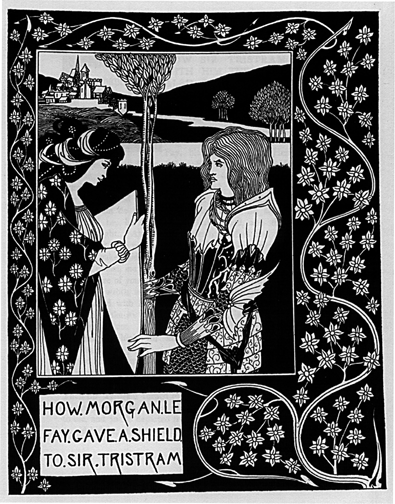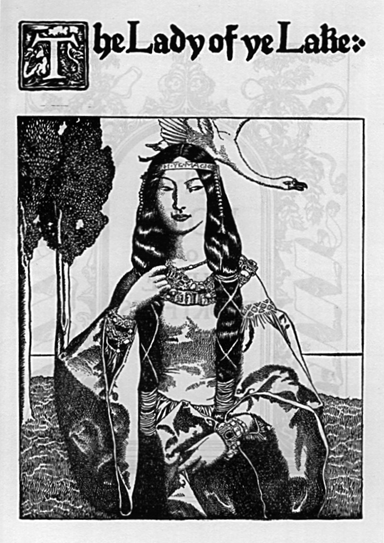
Aubrey Beardsley: How Morgan le Fay gave a Shield to Sir Tristram

Aubrey Beardsley: How Morgan le Fay gave a Shield to Sir Tristram
No one who encounters an enchantress comes away from the experience unchanged. Sometimes she will be the making of a man, granting him his heart's desire, enabling him to become what he should be ? whether hero or beast. Sometimes she will destroy him if he does not bend to her will, overwhelming him with all the power of her femininity and secret knowledge to bear upon him. The parts which the enchantress plays in the collective European imagination reveal the shared heritage of beliefs and symbols which we use to talk about our innermost fears and desires; the form which her enchantment takes in successive cultures tells us much about human society, subverted and challenged by the magical forces she brings to bear upon it.
Morgan le Fay is the greatest of European enchantresses. From the far north
of Europe to the island of Sicily she is known in a myriad of guises. Wise
healer, cunning seductress, tempter of good knights, enemy of Arthur and
watcher over his final rest, Morgan's roles multiply in medieval tradition;
she is Arthur's saviour, his political opponent, or the woman who
seeks to show him the truth about his wife and closest friend; in modern
re-envisionings she is a mystic, healer and wise woman, Arthurís
first and truest lover. She reflects medieval thinking about the family
dynamic of sisterhood, about female knowledge drawn from traditions beyond
the evolving model of the Latin-speaking university, about the politics
of the blood and the marital family. How did Morgan come to fill so many
complex and contradictory roles in Arthurian and other traditions - for
she is also the lover of Julius Caesar, mother of Oberon, king of the fairies,
and the cruel mother of La Pulzella Gaia, her beautiful daughter in late
medieval texts?
Beside Morgan, two other enchantresses are major players in Arthurian tradition: the mysterious Nimue or Viviane, and the Lady of the Lake. Viviane is Merlinís nemesis, a woman who refuses to exchange her virginity for the magical knowledge she desires; who brings the prophet his greatest happiness as well as his terrifying end. Viviane displaces Morgan as the archetype of feminine deceit and evil for the Victorian period; her destruction of Merlin, the sage and statesman through sexual guile offered a resonant warning to the mid-Victorian male. The Lady of the Lake outwits Merlin, replaces him at the Arthurian court when he is lost, and successfully rears and trains the most important hero of the Arthurian world, Lancelot of the Lake. Other enchantresses make their appearance in Arthurian literature; subverting their knowledge to superficial and misguided ends, for the seduction of young men and the maintenance of their own beauty.

Howard Pyle: The Lady of the Lake
Morgause, Queen of Orkney, Morganís sister and double, sometime enchantress, sometime loving mother of the hero Gareth, incestuous lover of Arthur and mother of his deadly enemy, Mordred, emerges as a focus for the many meanings projected upon the enchantress in medieval and modern literature. She both merges with and differentiates herself from Morgan, in a range texts, embodying a problematic motherhood in a way that Morgan does not, and becoming the victim of the masculine struggle for honour, instead of a major player in the competitive arena of the Round Table.
The unfolding
of their stories gives important insights into the history of human psychology;
longing for, and fear of, women and of the beautiful. The different
stories reflect the contexts in which they were told and the contemporary
anxieties, dreams, and desires which the enchantress embodies. Each enchantress
has a powerful intertextual existence independent of her appearance in
any one text; each text modifies and extends the roles available to the
whole cast of Arthurian characters in their relation to the magical. Based
on authoritative knowledge and years of research, ranging widely through
Europe, bringing together myth, legend, romance, music, and literature,
Morgan
and her Sisters explores a fascinating and little-known theme in western
tradition.